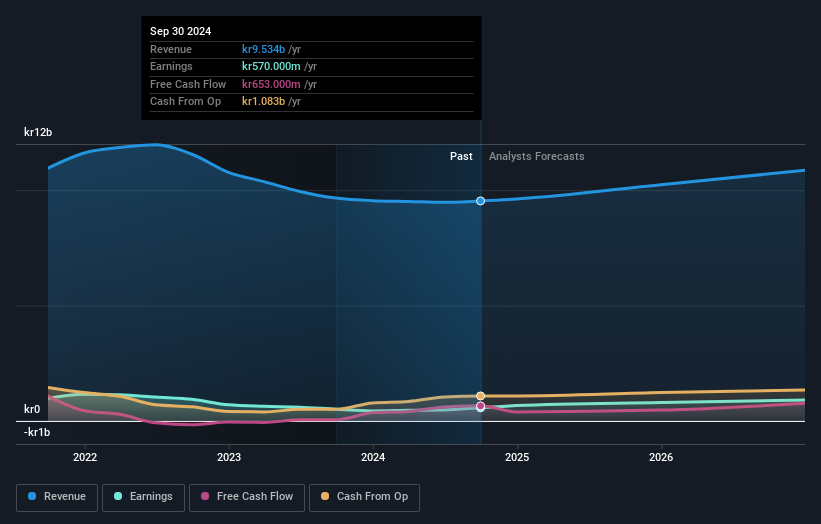- Sweden
- /
- Industrials
- /
- OM:NOLA B
Both individual investors who control a good portion of Nolato AB (publ) (STO:NOLA B) along with institutions must be dismayed after last week's 3.8% decrease

Key Insights
- The considerable ownership by individual investors in Nolato indicates that they collectively have a greater say in management and business strategy
- The top 25 shareholders own 48% of the company
- Insiders have bought recently
Every investor in Nolato AB (publ) (STO:NOLA B) should be aware of the most powerful shareholder groups. We can see that individual investors own the lion's share in the company with 51% ownership. In other words, the group stands to gain the most (or lose the most) from their investment into the company.
While institutions, who own 48% shares weren’t spared from last week’s kr579m market cap drop, individual investors as a group suffered the maximum losses
Let's delve deeper into each type of owner of Nolato, beginning with the chart below.
See our latest analysis for Nolato

What Does The Institutional Ownership Tell Us About Nolato?
Many institutions measure their performance against an index that approximates the local market. So they usually pay more attention to companies that are included in major indices.
Nolato already has institutions on the share registry. Indeed, they own a respectable stake in the company. This can indicate that the company has a certain degree of credibility in the investment community. However, it is best to be wary of relying on the supposed validation that comes with institutional investors. They too, get it wrong sometimes. When multiple institutions own a stock, there's always a risk that they are in a 'crowded trade'. When such a trade goes wrong, multiple parties may compete to sell stock fast. This risk is higher in a company without a history of growth. You can see Nolato's historic earnings and revenue below, but keep in mind there's always more to the story.

We note that hedge funds don't have a meaningful investment in Nolato. Looking at our data, we can see that the largest shareholder is Nordea Investment Management, AB with 9.6% of shares outstanding. With 9.1% and 6.3% of the shares outstanding respectively, Forsta AP-fonden and E. Öhman J:or Wealth Management are the second and third largest shareholders.
Our studies suggest that the top 25 shareholders collectively control less than half of the company's shares, meaning that the company's shares are widely disseminated and there is no dominant shareholder.
While it makes sense to study institutional ownership data for a company, it also makes sense to study analyst sentiments to know which way the wind is blowing. Quite a few analysts cover the stock, so you could look into forecast growth quite easily.
Insider Ownership Of Nolato
While the precise definition of an insider can be subjective, almost everyone considers board members to be insiders. Company management run the business, but the CEO will answer to the board, even if he or she is a member of it.
Most consider insider ownership a positive because it can indicate the board is well aligned with other shareholders. However, on some occasions too much power is concentrated within this group.
Our information suggests that Nolato AB (publ) insiders own under 1% of the company. Keep in mind that it's a big company, and the insiders own kr37m worth of shares. The absolute value might be more important than the proportional share. It is always good to see at least some insider ownership, but it might be worth checking if those insiders have been selling.
General Public Ownership
The general public, mostly comprising of individual investors, collectively holds 51% of Nolato shares. With this amount of ownership, retail investors can collectively play a role in decisions that affect shareholder returns, such as dividend policies and the appointment of directors. They can also exercise the power to vote on acquisitions or mergers that may not improve profitability.
Next Steps:
I find it very interesting to look at who exactly owns a company. But to truly gain insight, we need to consider other information, too. To that end, you should be aware of the 1 warning sign we've spotted with Nolato .
Ultimately the future is most important. You can access this free report on analyst forecasts for the company.
NB: Figures in this article are calculated using data from the last twelve months, which refer to the 12-month period ending on the last date of the month the financial statement is dated. This may not be consistent with full year annual report figures.
Valuation is complex, but we're here to simplify it.
Discover if Nolato might be undervalued or overvalued with our detailed analysis, featuring fair value estimates, potential risks, dividends, insider trades, and its financial condition.
Access Free AnalysisHave feedback on this article? Concerned about the content? Get in touch with us directly. Alternatively, email editorial-team (at) simplywallst.com.
This article by Simply Wall St is general in nature. We provide commentary based on historical data and analyst forecasts only using an unbiased methodology and our articles are not intended to be financial advice. It does not constitute a recommendation to buy or sell any stock, and does not take account of your objectives, or your financial situation. We aim to bring you long-term focused analysis driven by fundamental data. Note that our analysis may not factor in the latest price-sensitive company announcements or qualitative material. Simply Wall St has no position in any stocks mentioned.
About OM:NOLA B
Nolato
Develops, manufactures, and sells plastic, silicone, and thermoplastic elastomer products for medical technology, pharmaceutical, consumer electronics, telecom, automotive, hygiene, and other industrial sectors in Sweden, Other Nordic countries, Asia, Rest of Europe, and North America, and internationally.
Excellent balance sheet with proven track record and pays a dividend.


